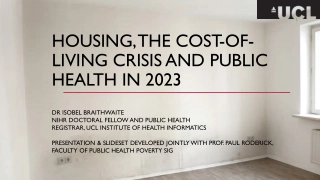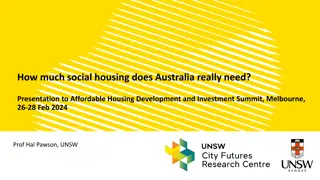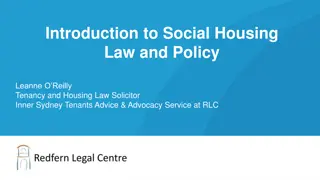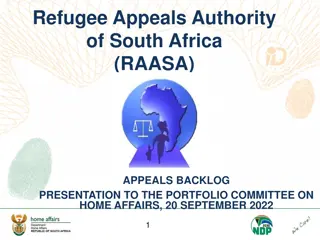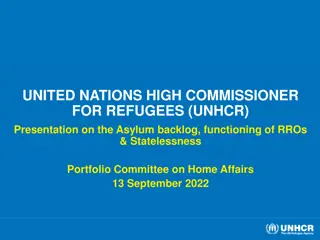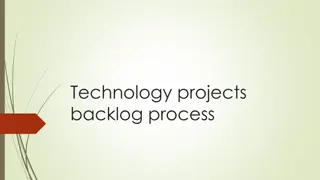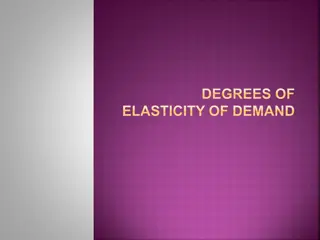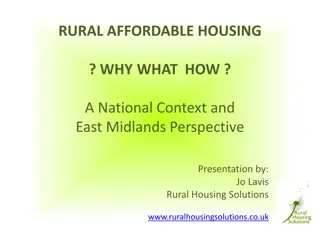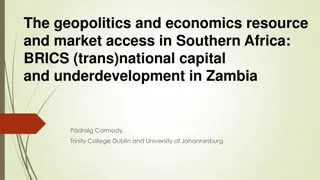Housing Challenges in South Africa: Backlog, Policies, and Demand
The housing situation in South Africa faces challenges despite policy frameworks aiming for adequate, sustainable housing for all. With a significant backlog, the demand greatly exceeds supply, leading to issues like informal settlements and slums. Policies like the Housing Act of 1997 and targets set by the government strive to address these challenges, yet the backlog persists, requiring significant resources for eradication.
Download Presentation

Please find below an Image/Link to download the presentation.
The content on the website is provided AS IS for your information and personal use only. It may not be sold, licensed, or shared on other websites without obtaining consent from the author.If you encounter any issues during the download, it is possible that the publisher has removed the file from their server.
You are allowed to download the files provided on this website for personal or commercial use, subject to the condition that they are used lawfully. All files are the property of their respective owners.
The content on the website is provided AS IS for your information and personal use only. It may not be sold, licensed, or shared on other websites without obtaining consent from the author.
E N D
Presentation Transcript
Housing backlog: Protests and the demand for Housing in South Africa BY ESTERI MSINDO PSAM
Housing delivery law and regulation Section 26 of the constitution stipulates that everyone has the right to adequate housing; the state must take reasonable legislative and other measures within its available resources, to achieve the progressive realisation of this right . Housing Act 1997 provides for the facilitation of a sustainable housing development process and lays down the roles, responsibilities and functions of the different spheres of government. The National Norms and Standards-Each house must have 40m of floor space, two bedrooms, a separate bathroom with a toilet, a shower and hand basin, and a combined living area and kitchen. Other Acts include the PIE Act (1998),the Rental Housing Act(1999),the social Housing Act (2008) The Sustainable Development Goal 11 seeks to make cities inclusive, safe, resilient and sustainable- South Africa adhere to the SDG The International Covenant on Economic, Social and Cultural Rights (ICESCR)- Adequate housing secure; having electricity, water and sanitation; affordable; habitable guarantying physical safety and accessible
South African Policy on Housing 1994 Housing White Paper(Reconstruction and Development Programme)- provided a framework for housing development target of building 1million state funded houses, within the first 5 years a target of 338 000 units per year 2004 Breaking New Ground- Outlines a comprehensive plan for the development of sustainable human settlements. Policy shift from quantity to quality and emphasised on the process of housing delivery, i.e. the planning, engagement and the long-term sustainability of the housing environment. Key objective- to eradicate all informal settlements White Paper on Human Settlements in Progress- Policy affirms the development of sustainable human settlements through partnerships with the private sector, communities and individual households in order to deliver sustainable and affordable accommodation in close proximity to social and economic opportunities
Demand far exceeds supply Moving target Target that is never achieved Housing problem- Wicked problem-addressing the problem creates more problems (Le Roux, 2011) South Africa s living conditions has generally improved since 1994-77.7% live in formal dwellings, 85.4% have access to electricity, 89.9 % have access to piped water and 66.4 % partially own/own dwellings BUT 14% still live in informal dwellings ie slums, backyard dwellings By 2014 about 4.3 million RDP houses were constructed since 1994 Housing Backlog in 2014 2.3 million, Current backlog- about 2.3 million and backlog growing at 178 000 units per year (Africacheck.org) About R800 billion required to eradicate the backlog by 2020
Housing backlog by provinces Province RDP dwellings 2016 RDP houses backlog 2016/17 community survey Estimates North West 261 693 237 000 Western Cape 571 997 526 000 Gauteng 1 227 729 600 000 Mpumalanga 241 801 170 000 Northern Cape 105 541 52 000 Free State 289 414 Figure not available Kwazulu Natal 559 302 716 079 Limpopo 260 976 157 420+ Eastern Cape 386 802 600 000+ National 2,3 million
Backlog by provinces Observation Gauteng province has the highest housing needs far above all the other provinces, yet the highest number of RDP houses were constructed in the province. This is due to population migration pattern. The Gauteng province is the economic hub of the country and people migrate from around the country in search of work The Eastern Cape and KwaZulu Natal Provinces, KwaZulu Natal and the Western Cape Provinces have a fairly high number of RDP dwellings, but the provinces still have above 500 000 housing backlogs. The Northern Cape has the list RDP dwellings and the list backlog. The province has the list population, is the most sparsely populated with relatively small economy
Expenditure on human settlements increase on average Table 1.3 Consolidated government expenditure by function 2016/17 2017/18 Average growth 2016/17-2019/20 Billion Basic education Economic affairs Defence, public order and safety Human settlements and municipal infrastructure Health Social protection General public services Post-school education and training Agriculture, rural development and land reform Allocated expenditure Debt-service costs Contingency reserve Consolidated expenditure Revised Estimate Budget estimate 226.6 201.7 190 179.8 170.9 164.9 70 69 26 1 394.8 146.3 6 1 563.1 243 215 7.30% 6.60% 5.80% 8.00% 8.30% 8.20% 2.60% 9.20% 4.70% 7.10% 10.50% 198.7 195.8 187.5 180 70.7 77.5 26.5 162.4 1 445.2 7.90%
The departments budget for 2016/17 amounts to R30.7 billion and is expected to increase to R37.4 billion in 2019/20, at an average annual rate of 6.9 per cent. Over the next three years, the department plans to initiate 25 catalytic projects that it will use as the main driver for delivering housing opportunities. Housing opportunities are implemented by provinces, metropolitan municipalities and public entities that are funded through conditional grants and transfers to departmental agencies and accounts. The budget for these transfers is located in the Housing Development Finance programme and is expected to increase at an average annual rate of 7 per cent over the medium term, from R29.8 billion in 2016/17 to R36.6 billion in 2019/20. As a result, the department expects to facilitate the delivery of 368 530 fully subsidised units, disburse 66 554 finance- linked individual subsidies and upgrade 623 635 houses in informal settlements by 2019 - SOURCE: 2017 NATIONAL HUMAN SETTLEMENTS BUDGET available on www.treasury.gov.za
What the Department of Human Settlement is doing to deal with the backlog Growing the budget -Although budget allocation for human settlement as a share of the total budget is only 5%, the budget grows above 8%, higher than the average growth of other sectors such as basic education, economic affairs and defence, public order and safety Increasing the budget can address the backlog if its increased enough to cover rising inflation and the growing demand resulting from population growth and other factors. About R800 billion required to eradicate the backlog by 2020.
Increasing targets and outputs Increasing the housing targets- An increase in the housing targets if the targets do not meet demand does not clear the backlog. In 2016/17 financial year 108 017 subsidy units were projected and 168 321 was achieved within 6 months of the financial year, Target for 2015/16 for subsidy units was 103 983 and 39 975 was achieved within 6 months. In 2016/17 the HSD achieved 60 000 above the target in the year 2016/17 and 64 000 less from reaching the target in 2015/16. Both the target and output for last year financial year increased for subsidy units The current output can not clear the current backlog of 2.3 million
Community Protests Protest - an expression or declaration of objection, disapproval or dissent, often in opposition to something a person is powerless to prevent or avoid Causes and theoretical perspectives Historical- Protests used pre-apartheid to push government. They have become a tool to show discontent Structural-Inequality causes protests (revolt of the poor) Psychological- Disparity between people s expectations and reality resulting in frustration and dismay Demand for human agency-Community want more engagement with government and want to influence development and change. They want to determine what services are provided and how. Central to any protest is the demand for a specific service e.g water & electricity, houses, infrastructure. However protests are a form of resistance to government plans e.g protests against municipal demarcation in Vuwani
Protest frequency for all municipalities(January to September 2015) 250 200 Protest frequency 150 100 50 0 2004 2005 2006 2007 2008 2009 2010 2011 2012 2013 2014 2015 Years
Community protests/Housing protests Community protests are generally on the rise in South Africa and these are concentrated in metropolitan areas, cities, major towns and mining areas Between 2014 and 2015, police responded to 2045 protests in the Eastern Cape on service delivery over housing, water and electricity The University of Johannesburg Social Change Research Unit reported 13 protests in 2004, rising to a peak of 470 in 2012, before falling to 287 in 2013. In fact, observation has shown that there are four times more protests over houses than any other service.
Housing backlog persists- Protests continue: what should be done The housing backlog can not be done away with and protests over houses are unlikely to stop Should focus be on minimizing protests through public participation or fighting the moving target Focus should be more on engaging with the community, while on the other hand government continue to progressively provide adequate housing to the people. The RDP housing program or free housing should not be the main focus of the DoHS. The community should be encouraged to engage in self sustainable economic activities Public participation allows communication between government and the citizens. Engagement with community helps inform government on the changing needs or reprioritisation of the community in order to inform policy. Maladminstration, corruption and capacity issues need to be addressed on house delivery
What should be done cont- Housing problem needs to be addressed holistically ie in relation to economic growth/job creation, education, rural development, agriculture etc. Government must consider increasing budget on rural development which has direct impact on rural-urban migration. Quality education should be accessible by the less advantaged citizens. Adequate and quality education enables citizens to be economically independent and be able to enter the property market.
Conclusion Housing backlog can not be easily addressed and therefore housing protests continue to be a challenge to South Africa Although there is a general growth in the budget for housing, the government can not meet the demand for housing. Public participation at municipal level should be done in such a way that the citizens are involved in determining their own needs and are involved when projects are planned and implemented Economic empowerment and provision of quality and adequate education wean citizens from depending on the state for housing. The backlog can not be cleared by increasing housing outputs, The housing problem is dependent upon other factors such as unemployment, slow economic growth, rural underdevelopment and a lack of quality education for the poor


